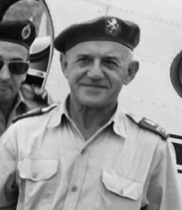Frédéric Vandewalle
Frédéric Vandewalle | |
|---|---|
 | |
| Birth name | Frédéric Vandewalle |
| Born | July 7, 1912 Arlon, Belgium |
| Died | 5 November 1994 (aged 82) Anderlecht, Brussels, Belgium |
| Years of service | 1937–1967 |
| Rank | Colonel |
| Unit | Force Publique Congolese National Army |
| Battles / wars | Simba rebellion |
| Signature |  |
Frédéric Vandewalle (Arlon, 5 July 1912 – Anderlecht, 5 November 1994)[1] was a Belgian colonel and diplomat in the Belgian Congo and independent Congo. He was an influential figure right before and after Congo's independence from Belgium. He was one of the organisers of the Katangese secession and led Operation Ommegang against the Simba rebellion during the Congo Crisis. His precise role in the assassination of Patrice Lumumba is the subject of debate among historians.
Career
Vandewalle joined the colonial forces called
After the
Vandewalle was severely injured in 1966 in a car crash where his wife died. He recovered and started to extensively write about his Congolese experiences. He also appeared on television:
Vandewalle's personal papers are kept at the Royal Museum for Central Africa in Tervuren, Belgium.
Publications
- "Les mutineries au Congo Belge", in: Zaïre, 1947, nr. 5, p. 487-514
- "Deuxième note au sujet des mutineries au Congo Belge", in: Zaïre, 1948, nr. 2, p. 905-906
- Congo 1960-1964. Conférence donnée à Arlon le 6 juin 1968 à l'Ecole d'infanterie, 1968
- L'Ommegang. Odyssée et reconquête de Stanleyville, 1964. Témoignage africain, 1970
- Les Rapports secrets de la Sûreté congolaise (1959-1960), 1973, 2 parts (with Jacques Brassinne de La Buissière).
- Mille et quatre jours. Contes du Zaïre et du Shaba, 1975–1977, 13 parts.
- Une ténébreuse affaire, ou Roger Trinquier au Katanga, 1979.
- "A propos de la gendarmerie katangaise" in: Bulletin trimestriel du CRAOCA, 1987, nr. 1, p. 65-92
Literature
- "In memoriam Frédéric Vandewalle", in: Annales Aequatoria, 1995, nr. 16, p. 618
- Frédéric Vanderwalle Papers, AfricaMuseum
Footnotes
This section is empty. You can help by adding to it. (October 2020) |
References
- ^ "Vandewalle, Frédéric". AfricaMuseum. Retrieved 18 November 2020.
- ISBN 978-90-223-3076-0.
- ^ Frank Villafana, Cold War in the Congo. The Confrontation of Cuban Military Forces, 1960-1967, 2017, p. 76-77
- ^ Interview by Jean Vanwelkenhuyzen, 22 February 1972
- ^ Ludo De Witte, De moord op Lumumba, 1999, p. 50-51
- ^ Verslag van de parlementaire onderzoekscommissie belast met het vaststellen van de precieze omstandigheden waarin Patrice Lumumba werd vermoord en van de eventuele betrokkenheid daarbij van Belgische politici, 16 November 2001, vol. I, p. 262
